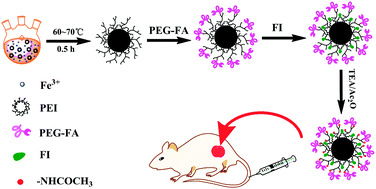We present the polyethyleneimine (PEI)-assisted synthesis of folic acid (FA)-functionalized iron oxide (Fe3O4) nanoparticles (NPs) with ultrahigh relaxivity for in vivo targeted tumor magnetic resonance (MR) imaging. In this work, water-dispersible and stable Fe3O4 NPs were synthesized in the presence of PEI via a facile mild reduction approach. The surface PEI coating afforded the formed Fe3O4 NPs with the ability to be functionalized with polyethylene glycol (PEG)-linked FA and fluorescein isothiocyanate (FI). A further acetylation step to neutralize the remaining PEI surface amines gave rise to the formation of multifunctional FA-functionalized Fe3O4 NPs, which were subsequently characterized via different methods. We show that the developed FA-functionalized Fe3O4 NPs have a good water-dispersibility, good colloidal stability, ultrahigh r2 relaxivity (475.92 mM−1 s−1), and good hemocompatibility and cytocompatibility in the studied concentration range. The targeting specificity of the FA-modified Fe3O4 NPs to FA receptor (FAR)-overexpressing HeLa cells (a human cervical carcinoma cell line) was subsequently validated by flow cytometry and confocal microscopy. Significantly, the developed FA-modified Fe3O4 NPs can be used as a nanoprobe for targeted MR imaging of HeLa cells in vitro and the xenografted tumor model in vivo via an active FA-mediated targeting strategy. The developed multifunctional FA-modified Fe3O4 NPs with an ultrahigh r2 relaxivity may be used as an efficient nanoprobe for the targeted MR imaging of various kinds of FAR-overexpressing tumors.
